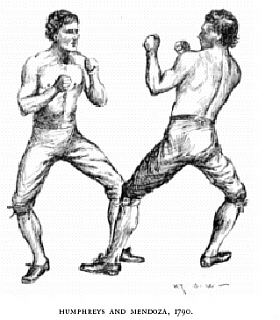The boom probably reached its zenith between the years 1734 and 1750, at which period Jack Broughton flourished. To this worthy we are indebted for the invention of the boxing glove, or muffler, it was then called. as well as for the first rules, which, although then few and brief, are yet the foundation of the present rules. He is also said to have propounded a system of hits and guards; but he probably adhered to the prevailing custom of the time among professors of fencing, etc., namely, that of swearing his pupils to secrecy in regard to their instructions; anyhow, we have been unable to find any record of his system. After him pugilism seems to have begun to lose favor, and 1761 found it at a low ebb of popularity. Tom Johnson, by his gallant fighting and manly conduct, particularly in his fight with Perrins, restored it to public favor, and this was the beginning of the period of highest prosperity for the ring, |
which lasted until the retirement of Tom Spring in 1824, during which time Humphreys, Mendoza, "Gentleman" Jackson, Belcher, Pearce (the "Game Chicken"), Gulley (who became a member of the British Parliament), Cribb, Spring, Randall, Curtis and Dutch Sam flourished. It was resuscitated again for a time by the splendid battles for the championship of Tom Sayers from 1851 to 1860, only finally to expire in 1863. This time its decline and fall were not owing to lack of quality, for the art had more nearly attained perfection than ever before, but in consequence of the practices of those barnacles of sport, the professional gamblers. The popularity of pugilism in the form of boxing matches is too well known to demand detailed notice, and it is safe to assume that as a sport it will continue to flourish while promoted and managed by reputable clubs. Progress in the art of boxing since 1700 has been rather in the direction of condensing what was already known than in adding to it. Thus, as early as 1719 Figg was noted for his "stops and guards," and accounts of fights teem with mention of chopping hits, back and in handed hits and uppercuts.  |
 THE art of boxing has had its alternations of popularity and disfavor. Brought into prominence by James Figg in London, in 1719, as an interlude in entertainments given by exponents of back sword, cudgel play, etc., it speedily became popular with all classes. Its rough-and-ready nature and the opportunities it gave for the display of skill, pluck and endurance could not fail to make the art a favorite among a people so largely endowed with every qualification for its development as the Anglo- Saxon race. Figg opened his boxing academy in the Tottenham Court road and it was liberally patronized by many royal and noble personages, who supported the exhibition as tending to hardihood and intrepidity. The particulars of the entertainment were duly chronicled in publications of such literary fame as the Tattler, Guardian and Craftsman.
THE art of boxing has had its alternations of popularity and disfavor. Brought into prominence by James Figg in London, in 1719, as an interlude in entertainments given by exponents of back sword, cudgel play, etc., it speedily became popular with all classes. Its rough-and-ready nature and the opportunities it gave for the display of skill, pluck and endurance could not fail to make the art a favorite among a people so largely endowed with every qualification for its development as the Anglo- Saxon race. Figg opened his boxing academy in the Tottenham Court road and it was liberally patronized by many royal and noble personages, who supported the exhibition as tending to hardihood and intrepidity. The particulars of the entertainment were duly chronicled in publications of such literary fame as the Tattler, Guardian and Craftsman.